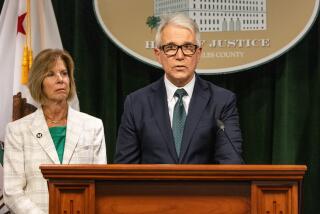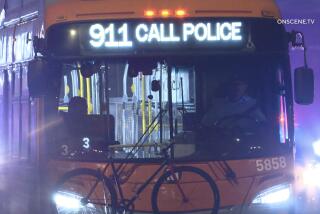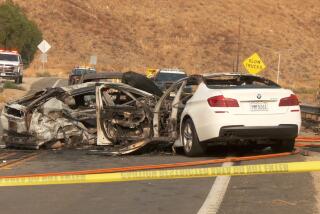18 Santa Monica Residents Die as Bus Falls in River : 22 Injured as Driver Loses Control of Vehicle on Eastern Sierra Highway
BRIDGEPORT, Calif. — At least 18 elderly Santa Monica residents bound for home from a Nevada gambling excursion were killed Friday morning when their tour bus careened off a mountain highway in the eastern Sierra and tumbled into an icy, swollen river.
The California Highway Patrol reported 22 passengers injured, several critically. One person was listed as missing and presumed dead, and as night fell searchers combed the downstream banks of the rushing river for the body. (Names of the injured on Page 12.)
Witnesses told California Highway Patrol investigators that the coach, registered to Starline Sightseeing Tours of Hollywood, appeared to be traveling slightly faster than the 55-m.p.h. speed limit when the driver lost control of the vehicle.
Officer Michael Slappey, the lead investigator, said the bus driver apparently struggled mightily at the steering wheel of the hurtling, southbound coach before it flipped over and rolled down an embankment and into the West Fork of the Walker River.
“There are skid marks all over the highway,” Slappey said.
Victims Swept Away
The bus came to rest upright atop a half-submerged rock. The roof and one side of the red-white-and-blue coach were crushed. Its back end was farthest from shore, and the aft seats were completely underwater.
The river, cold and swift from melting winter snow, surged through the crushed bus, sweeping away some of the elderly passengers.
“My husband was thrown out the window,” said Valerie Webb. She was flung into the aisle of the bus and bodies piled on top of her. “I thought he was floating down the river. It was terrible not knowing where he was.”
Her husband, Buster, was later found by rescuers and the Webbs, both in their 70s, were said to be in good condition Friday night in Northern Inyo Hospital in Bishop.
Rescue workers said the bodies of four victims were found half a mile downstream.
Die of Head Injuries
Doctors who rushed to the accident site said other victims succumbed to head injuries caused either by granite rocks that covered the embankment or impact against the roof of the bus as it was crushed down upon them.
Some passengers, pinned in the flattened wreckage, died of hypothermia from exposure to the icy water before rescuers could reach them, doctors said.
The driver was identified as Ernst A. Klimeck, a 48-year-old Hollywood resident who had been employed by the tour bus company for two years. He was reported in serious but stable condition at a Reno hospital Friday evening.
“The driver was sitting up on the road when we arrived,” said Allen Smith, a Mammoth Lakes firefighter who was among the first rescuers. “His only response . . . was that he had no idea what happened and he continually questioned bystanders, ‘Did anybody know what happened?’ ”
Investigators said preliminary indications were that Klimeck was simply driving too fast to maintain control of the 1985, German-made coach as it climbed a rare straightaway in the twisting road that parallels the river. No other vehicle was believed to have been involved in the crash. Rumors abounded about the cause, including one unverified report that Klimeck had told a rescuer that a tire had blown out.
The weather at the time of the 10:30 a.m. accident was clear and the road surface was dry, officials said. Starline Tours said the vehicle was equipped with seat belts, although doctors who treated the injured said it appeared the passengers were not strapped in at the time of the accident.
Richard Trevena, a CHP public affairs officer, said witnesses related that the bus “may have been going a little too fast. The investigating officer heard an estimate of about 60 m.p.h.” The speed limit at that section of road is 55 m.p.h. with warning signs advising speeds of 35 m.p.h. through curves.
First Major Accident
Officials at Starline Tours said it was the first major accident in the Hollywood-based company’s 15 years of charter service in California and Nevada.
Company officials said the coach had been chartered by residents of Santa Monica Christian Towers, a 13-story apartment tower near Wilshire Boulevard and 6th Street.
Ida Quaif, manager of the 195-resident facility, said the tenants organize visits to Nevada casinos about once a year. She said 46 residents had signed up for this charter, which departed for Las Vegas, Lake Tahoe and Reno on Tuesday and was to have returned home Friday night. They paid $135 apiece.
Quaif, sobbing and clutching her head, recounted that she and three other residents had decided to pull out of the trip shortly before departure.
“We were supposed to be on there too,” she said, “but my blood pressure went up so I couldn’t go.”
Quaif said the tour group consisted mainly of women, aged 62 to 96. As reports of the accident began to circulate through the large tower, elderly residents gathered in small groups to share scarce details, and their grief.
She said 26 to 28 of the passengers lived in the tower and the others lived nearby.
For the neighbors of the victims, realization of what transpired had come in awful waves during the day, as news reports became more precise. “We heard about it first on the radio,” said Quaif, “and the more I kept hearing the more I said I knew it was our bus. When they said it was 40-some people on the bus, I knew it was us.”
Earlier Delays
Residents said that one passenger on the tour called Tuesday and reported delays had been caused on the outbound journey by an unspecified mechanical breakdown. They said it was the first time the home had employed the tour company.
The high point of the four-day outing was a barbecue luncheon Thursday at the Nevada Governor’s Mansion in Carson City. The tour was scheduled to stop in Bridgeport for lunch Friday before commencing the final leg of their journey.
The accident occurred in Mono County, 20 miles north of Bridgeport on U.S. 395, the main route linking Southern California with Reno, in a canyon pass called Mountain Gate, a short distance east of Yosemite National Park.
Tire marks indicated that the bus skidded across the highway into a wire fence erected to keep canyon rocks from rolling onto the road. The coach deflected off the fence, back toward the right side of the highway, which borders the river, authorities said.
It appeared that the driver then turned hard to prevent the coach from plunging over the side of the road, and at that point, almost 300 feet from the start of the skid marks, the bus rolled over, flipped two or three times down a 45-foot embankment and into the river, spilling bodies and debris into the raging current.
Military Team Called In
“There were bodies all over everywhere,” said the CHP’s Slappey.
The crash was witnessed by two fishermen, officials said. Motorists who quickly happened upon it helped retrieve bodies from the wreckage. Others put the injured in their cars and sped toward the hospital here.
“It was a horror,” said Judy Sobel of Van Nuys. One of the first at the scene, she dismounted from her motorcycle and helped pull half a dozen passengers from the bus. “It was sickening,” she said.
Irv Pigovat of Redding, another motorist who stopped to help, said the crash scene looked “like a battlefield. The bodies were entangled. There was a lot of blood and a lot of people in pain.”
Rescuers were summoned from throughout the eastern Sierra Nevada. At least 30 ambulances drove toward the scene, along with three helicopters and two airplanes called in to ferry victims to hospitals.
Marine Sgt. Todd McLauchlin was part of a team of Marines and Navy corpsmen dispatched from a nearby mountain warfare training camp to join the frantic effort to pluck survivors and victims from the bus and river.
He described what he saw upon arrival, about half an hour after the accident: “The bus was in the water and there still were 10 or 12 people inside. Some of the bodies were carried downstream. We took four dead out of the water about a half a mile downstream.”
Tow trucks were backed up to the bank and lashed to the bus to prevent it from floating downstream.
The Marines ran a rope from the shore to the broken front window of the bus. One by one the survivors were strapped to backboards and gently passed along the rope to the shore.
Witnesses said the evacuation was orderly, and the elderly appeared more stunned than panicked.
Only One Doctor
Dr. Rick Tietz was the only doctor at the 25-bed Mono General Hospital here when the accident was reported. There is no other hospital within 60 miles of the crash site.
Tietz called in another doctor to watch over the hospital and then headed to the crash site. There he found the elderly scattered everywhere, some scrambling up the bank, others still trapped inside the bus.
The 31-year-old doctor established a triage station on the riverbank, sifting among the injured to determine those most in need of immediate treatment.
“There were massive chest wounds and head wounds,” he said. “There were massive chest injuries, bruises, lungs full of water. Some were suffering from hypothermia. There were still dead people in the bus.”
The dead were placed in yellow body bags that were arrayed haphazardly on the bank. The 16 most critical passengers were taken first to the hospital here and then transported by air and ground to hospitals in Reno, Carson City, Bishop and Mammoth.
“They are all elderly so they are going to have a tougher time than we’d expect,” said Dr. Robert Platt, an emergency room physician at the Washoe Medical Center in Reno, where seven patients were received, four in critical condition. “One is very critical, and we’re not sure she’ll make it through the night.”
Injured Dazed
Most of the injured were dazed. “The bus just veered left and then right,” said passenger Bob Roesger, his face cut and his shirt bloodied. He was being treated in the hospital here and was concerned because he had not been able to locate his wife.
It took officials several hours to sort out how many passengers had been aboard the bus and how many had survived. The confusion was compounded by their inability to find a manifest among the wreckage. By 10 p.m., however, a list had been found and Highway Patrol officials believed they had accounted for all but one of the passengers.
Most hospitals released names of those being treated.
The bodies were taken to the Mono County coroner for identification and notification of next of kin. Officials there said no names of victims would be released to the public until today, but at the Christian Towers the elderly tenants maintained a sorrowful vigil well into the night, anxiously awaiting word of who among their neighbors had survived, and who had died.
Half-Sunken Wreckage
At dusk, members of a CHP major accident team were bobbing about the half-sunken wreckage in life preservers, taking photographs. The National Transportation Safety Board announced in Washington that it would send six investigators.
The bus crash was among the worst in the nation’s history. In 1976, a busload of high school students from Yuba City in Northern California plunged off a freeway ramp, killing 28 of the pupils and a teacher. A tour bus carrying elderly crashed into a ravine in Arkansas in 1980, killing 20 people and injuring 13. Eleven people died and 13 were hurt in 1981 when a commuter bus dropped down an 80-foot embankment and into a creek near Quantico, Va., a suburb of Washington.
Ronald B. Taylor reported from Mono County and Peter H. King from Los Angeles. Times staff writers Mark A. Stein in Reno and Mariann Hansen in San Francisco also contributed to this story.
List of the 22 Injured at Six Hospitals
The 22 people injured in the tour bus crash near Bridgeport, Calif., and their condition, as reported Friday night by hospital spokesmen:
At Washoe Medical Center in Reno:
Bus driver Ernest Klimeck, 48, Hollywood, satisfactory condition.
Dr. Richard Butler, age unknown, Santa Monica, in the intensive care ward in serious condition.
Gifford Thrasher, 65, Santa Monica, in intensive care in serious but stable condition.
Lawrence Ward, age and address unknown, satisfactory condition.
Cecil Dryer, age and address unknown, serious condition with massive chest injuries.
Dorothy Krimbell, age and home town unknown, intensive care in serious but stable condition.
An unidentified woman, critical condition.
At Carson-Tahoe Hospital in Carson City, Nev.:
Grace Thrasher, 73, Santa Monica, serious but stable condition.
Dorothy Ward, 74, Santa Monica, stable condition.
Karen Patterson, 74, Santa Monica, serious but stable condition.
Daniel Goodrich, age unknown, Santa Monica, stable condition.
Margaret Goodrick, age unknown, Santa Monica, serious but satisfactory.
At St. Mary’s Hospital in Reno:
Warren Biscaluz, 68,
Bruce Hulderman, 60,
Richard Hassell, age unavailable.
All three are listed in critical but stable condition.
At Mono General Hospital in Bridgeport, Calif.:
Two unidentified patients, both female, stable condition.
(Times reporters spoke with one woman patient at this hospital not contained on lists provided by other hospitals. Her name was Mary Ainsworth.)
At Northern Inyo Hospital in Bishop, Calif.:
Ira (Buster) Webb, 71, Santa Monica, fair condition.
Valerie Webb, 71, Santa Monica, fair condition.
Robert Roesger, 59, Los Angeles, good condition.
At Centinela-Mammoth Hospital in Mammoth, Calif:.
One unidentified male, about 60, Santa Monica, serious but stable.
One unidentified female, about 60, Santa Monica, serious but stable.
More to Read
Sign up for Essential California
The most important California stories and recommendations in your inbox every morning.
You may occasionally receive promotional content from the Los Angeles Times.











